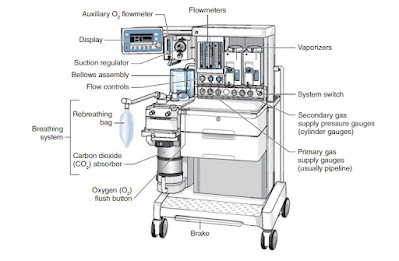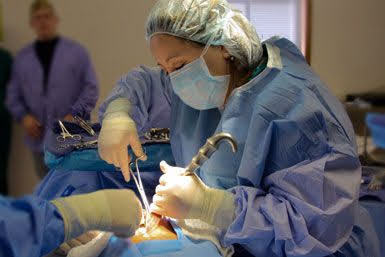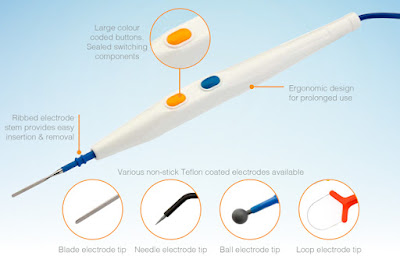Difference between anesthesia machine & ventilation machine
An anaesthetic machine (British English) or anesthesia machine (American English) is a medical device receives medical gases (oxygen, nitrous oxide, air) under pressure and accurately controls the flow of each gas individually. A gas mixture of the desired composition at a define flow rate is created before a known concentration of an inhalational agent vapour is added. Gas and vapor mixtures are continuously delivered to the common gas outlet of the machine, as fresh gas flow (FGF), and to the breathing system and patient.

Components of anesthesia machine:
It consists of
1.Gas supplier
2. Pressure gauges
3. Pressure regulators (reducing valves)
4. Flowmeters
5. Vaporizers
6. Common gas outlet
7. A variety of other features, e.g. high-flow oxygen flush, pressure relief valve and oxygen supply failure alarm and suction apparatus
8. Most modern anesthetic machines or stations incorporate a circle breathing system.
The machine is commonly used together with a mechanical ventilator, breathing system, suction equipment, and patient monitoring devices; strictly speaking, the term "anesthetic machine" refers only to the component which generates the gas flow, but modern machines usually integrate all these devices into one combined freestanding unit, which is colloquially referred to as the "anesthetic machine" for the sake of simplicity.
Ventilator
A ventilator, also known as a mechanical ventilator or respirator, is a medical device used to assist or replace a patient's breathing when they are unable to breathe on their own. Ventilators work by delivering oxygen to the lungs and removing carbon dioxide from the body.
Ventilators can be used in a variety of medical settings, such as intensive care units (ICUs), emergency departments, and operating rooms. They are typically used for patients who have respiratory failure due to conditions such as pneumonia, acute respiratory distress syndrome (ARDS), or chronic obstructive pulmonary disease (COPD).
Ventilators can be invasive or noninvasive. Invasive ventilators require the insertion of a tube through the mouth or nose and into the trachea, while noninvasive ventilators deliver air through a mask or nasal prongs.
Components of ventilator:
- Ventilator Settings: Controls for tidal volume, respiratory rate, and oxygen concentration.
- Breathing Circuit: Similar to that of an anesthesia machine, but designed for mechanical ventilation.
- Monitoring Equipment: Monitors respiratory parameters, including airway pressures and gas exchange.
Types of Ventilators
There are several types of ventilators that are commonly used in healthcare settings:
- Positive pressure ventilators: These ventilators deliver air or oxygen under pressure into the patient's lungs. The positive pressure helps to open up the airways and inflate the lungs.
- Negative pressure ventilators: These ventilators create a vacuum around the patient's chest, which causes air to flow into the lungs. Negative pressure ventilators are less commonly used than positive pressure ventilators.
- Volume-cycled ventilators: These ventilators deliver a preset volume of air or oxygen to the patient's lungs with each breath. This type of ventilator is commonly used for patients who are unable to breathe on their own.
- Pressure-cycled ventilators: These ventilators deliver air or oxygen to the patient's lungs until a preset pressure is reached. This type of ventilator is often used in critical care settings.
- Time-cycled ventilators: These ventilators deliver air or oxygen to the patient's lungs for a preset amount of time. This type of ventilator is commonly used for patients who require frequent suctioning.
- High-frequency oscillatory ventilators: These ventilators use high-frequency vibrations to deliver air or oxygen to the patient's lungs. This type of ventilator is often used for premature infants or patients with acute respiratory distress syndrome.
- Bi-level positive airway pressure (BiPAP) ventilators: These ventilators deliver air or oxygen at two different pressures, one for inhalation and one for exhalation. BiPAP ventilators are commonly used for patients with sleep apnea or chronic obstructive pulmonary disease (COPD).
Key Differences:
It's worth noting that different healthcare facilities may have different types of ventilators available, and the specific type of ventilator used will depend on the patient's individual needs and condition.


